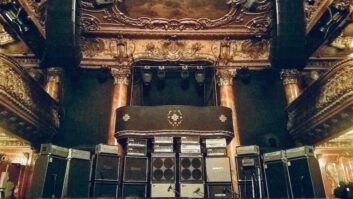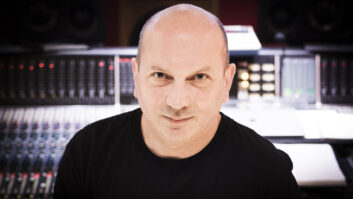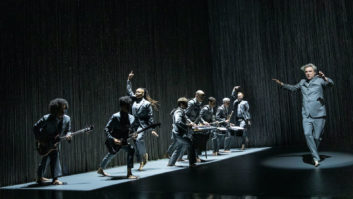In the age of MP3, some may despair about the long-range prospects for high-end audiophile recordings, but their numbers do not include Tam Henderson or Keith O. Johnson. Partners in Reference Recordings (along with “marketing maven” Marcia Martin), the producer and engineer celebrated the label’s 25th anniversary in 2001 by snaring their ninth Grammy nomination, and they are energetically planning for the future.
Johnson, whose resume includes co-inventing the HDCD process, was a founding partner at Pacific Microsonics, the company now owned by Bill Gates that released this technology. As a rule, he prepares for a recording session by absorbing scores and any interpretations of a work he can get his hands on. But one of his most recent assignments — engineering American composer Richard Danielpour’s expansive piece honoring the victims of the September 11th tragedy, An American Requiem — required Johnson to make a recording of a work he’d only heard once, a day before the session. What was it like to record, in three sessions, an hour-long work he barely knew that was scored for 250 musicians, including orchestra, chorus and three vocal soloists?
“Total panic!” says Johnson. “I like to get different slants on how a work is performed, and the sounds that people are going for. Then I have an idea of what I want to capture. We simply didn’t have that luxury with the Danielpour piece. Fortunately, Richard’s orchestration is exceptionally clean, and that makes the engineer’s job much easier. Amateur composers tend to pile sounds on top of each other and let the recording engineer sort things out.”
Commissioned by the Pacific Symphony Orchestra, An American Requiem was the final work composed by Danielpour during a three-year residency with the Orange County, Calif., arts organization. It was premiered and recorded at the Orange County Performing Arts Center, a space that Johnson found quite challenging. “The hall has very little reverb tail. I had to make decisions on-the-fly regarding how much ambience and reverb to add during the recording. We wanted to capture everything live, if possible, in order to eliminate the sonic degradation that comes with the audio post process. Usually, a console doesn’t have enough DSP to deal with the small pieces of information you want to preserve for high-end recordings.”
Tracking to Tascam DA-98 HR, DA-88 and DA-38 recorders, Johnson utilized the bit-splitting capability of the DA-98 to record the stereo tracks at a resolution of 24 bits/176.4 kHz. A surround mix, captured simultaneously, was recorded at 24 bits/88.2 kHz. “We did end up running out of space on the DA-88 that was tracking the surround mix, and ended up capturing the surround field itself at 20 bits,” he says. “That’s still a lot of information, and the idea is to get it all at once, if possible, and avoid having to go into post, where you’re placing a burden on a console to handle all of the data that’s on tape.
“I brought a pair of Lexicon reverb units — a PCM90 and 224XL — to provide delays and part of the signal mix to drive self-amplified speakers placed in the hall. Reverberation devices — with the possible exception of the latest Sony unit [the 888] — yield less resolution and more noise side bands than the other equipment we are dealing with. You can hear these artifacts when their electrical signals or reverberation feeds are mixed, so, instead, directional speakers were positioned to drive the most reverberant parts of the hall I could find. Then I placed microphones in these active areas to supply the reverberation feed. A little microphone feedback was mixed back to the reverberation units to help sustain and brighten the effect, and help balance the hall ambience.”
Johnson drove the hall with speakers to wet the sound, using a technique that traces back to the early London recordings on Decca. “We mix signals from ambience microphones that pick up both the sounds that naturally occur from that resonant space and the reflected sounds produced by the reverb speaker,” he explains. “In other words, the speaker, which I have constructed for this purpose, gets a mixture of reverb picked up by hall microphones, delayed feeds from instruments that do not couple or drive the space very well, solo singers and outputs from the reverberation units.
“The ear expects to hear more hall sound as amplitude rises. Consequently, if you raise the gain on a singer’s microphone to bring him forward, the listener expects more response from the hall, but that doesn’t happen here. To compensate, I took some of the singer’s signal, delayed it so that it lines up with the time frame of what the hall should sound like, and then mixed in some electronic reverb. We also blend in several reverberation mics from that area that are simply picking up some of the most reverberant sound in the hall. The result of this blend is an acceptable, though not world-class, reverberation effect.”
Many engineers recording large classical ensembles use spot mics to capture individual instruments during the tracking process, and then handle balances in the mix. But because the Reference label’s goal is to capture a performance as it happens, Johnson uses accent pairs instead of panned monaural spots. “We usually use cardioids or hyper-cardioids, but in stereo pairs. These mics have their own power suppliers and line amplifiers, which have equalization built in. They have different response curves than the more distant microphones. By properly adjusting these accent pairs, the listener hears the balance of an instrument as if it’s further away than it really is from the mic, which gives a more natural sound. The pairs are arranged in time phase. That way, if an instrument is on the left of the sound field, we can arrange them so that they impart this effect.
“Generally, we use old Sennheiser MKHs from the 1950s for both the main and accent pairs,” Johnson continues. “It’s a classic mic, but it’s extremely tricky to keep running. About half of my mics have diaphragms that are much thinner than the original issue; all have had the analog parts of the electronics replaced with direct-couple servo electronics. The original solid-state design is awkward and clumsy by today’s standards.
“We used Coles ribbons mics on all of the soloists. They’re very similar to the RCA 44BXs in their ability to produce a very natural voice sound. The 44s are actually superior in this regard, but they’re too fragile. Incidentally, the Coles are also probably the best mic for horns on the market.
“We placed a pair of omni mics across the front of the orchestra, a center pair of cardioids on the winds, and another pair of cardioids quite high over the percussion. To capture the chorus, we used a pair of high-placed omnis plus a pair of cardioids in the center. For the 5-channel feed, we blended in a center mic, which was placed in front of the orchestra.”
Johnson also designed and built the consoles used on this recording. “Three consoles were used on this project,” Johnson says. “One board creates the 2-channel CD mix. Another deals with the 5-channel mix, and a third handled the accent microphones; that board fed the other two. The only piece of electronics in the consoles is an active line drive, which takes the signals from these passive boards and boosts them so that they can be sent down a cable to the digital converters. We also used a little Mackie board for the reverberation signal. This board received signals from the other three consoles, mixed them and sent the signals to the speakers in the hall.”
Dealing with the large forces that Danielpour wrote for did not present unusual problems for Johnson. “The microphones and line-drive amplifiers had been set up for this kind of work. The master gain is pretty much plus or minus 3 dB to achieve the right level. I’ve done enough recordings to know approximately where that level is going to be. I carefully listen in on the orchestra as it’s tuning up. The most critical part for me was when the musicians were coming onstage and warming up. The only other time I had to get sound balances was when the orchestra and chorus were working some things out — maybe a five-minute period during which I made some trial fader moves and marked settings. The setup and recording times were very limited.”
Despite the pressures that came with tracking this Danielpour work, Johnson is pleased with the results. So is conductor Carl St. Clair. “The sound balances and ambience that Reference Recordings created in our center is amazing,” he says. “There is a wide spectrum of color and detail, and a great breadth of sound. I was extremely impressed with the division of the instrumental groups, which seemed miraculous to me. In a concert situation, you’re not making evaluations on these matters. You’re simply passing through time with a piece. But making a record is different. You want a note-perfect performance, if possible, with emotion, and you want it captured with the most detail possible. All of us associated with the Pacific Symphony believe that An American Requiem will join the canon of the great masses, and this recording will help establish it in the public’s mind.”
For Danielpour, whose works have largely been recorded on the Sony label, An American Requiem represented his first foray into production. “Most of my records had Steve Epstein as producer,” he notes. “Fortunately, Tam Henderson is a first-class producer and gentleman. Tam gave me a great deal of latitude regarding re-recording sections if I heard something that wasn’t quite right. I didn’t think it would be possible to record this work in three, three-hour sessions, but we did. A great deal of the credit goes to Carl and Reference Recordings. Sonically, I was amazed at the results.”
The Danielpour Requiem, which was rush-released in January, is quickly making fans, including producer Tam Henderson. “This is an extremely effective piece of choral music. It’s melodic, dramatic and very effective. I think it will become a repertoire item.”
For more, go towww.referencerecordings.com.







